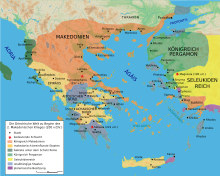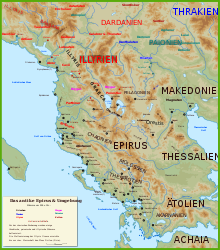Koinon
As Koinon ( κοινόν , dt. Community, community or federation; Pl. Koina (κοινά)) is an early form of federal political organization in ancient Greece in modern research . These states experienced their greatest time in the Hellenism .
term
Koinon initially only means "the common", the narrowing of the term to "covenant" is modern. For example, Koinon sometimes referred to the community of those who were somehow entitled to participate in political life, especially if they were not citizens of a city. For example, there was a Koinon of Macedonians (Κοινὸν Μακεδόνων) : It was the community of personally free Macedonians who faced the monarch in the state and, depending on the balance of power, could exert more or less influence on politics, for example when they were summoned by the king to the popular assembly.
The Greek Koina of Hellenism, on the other hand, was either a permanent union of previously independent city-states ( Poleis ) or, more rarely, state-like formations of tribes (Ethnos) in peripheral areas of the Greek world, where the Polis is not the predominant form of political rule was.
The amalgamation of several poleis to form a federation was mostly due to an external threat. The Koinon was thus, similar to a temporary symmachy , primarily a defensive alliance. A sharp demarcation between symmachy and koinon is not always possible. In the Koinon the members were generally equal and the agreement about it had a multilateral character, while symmachies were mostly grouped around a strong polis and their members were bound to the hegemon by individual bilateral agreements .
Typical characteristics
The Koina of Hellenism had in common that, in contrast to the alliances of the classical period (such as the Attic Sea League or the Peloponnesian League ), they had a common citizenship: the full citizens of a member polis also had the citizenship of the koinon. In contrast to a mere confederation of states , the resolutions and regulations of the federal government were also overriding the laws and decisions of the individual poleis. Although the common foreign and military policy was essential, the federal assemblies occasionally intervened in the internal affairs of the Poleis, up to and including the forced change of the constitution. The important Koina in particular often tried to expand through an aggressive expansion policy. A double membership of a polis in several Koina was not possible; an exit that took place without the consent of the Federal Assembly was usually forcibly prevented. The Koina often shared a common currency, a common army, common weights and measures. For practical reasons, they were based on the principle of representation, in contrast to most poleis, in which direct citizen participation was usually the ideal.
The internal autonomy enjoyed by the Poleis in the Koina (for example with regard to criminal law) fluctuated considerably; for example, it was apparently greater in the Aitolian covenant than in the Achaean covenant . Most Koina were institutionally structured in a similar way to the typical polis and therefore had a federal assembly that met two to four times a year and consisted of the representatives of the cities (often staggered according to size), a federal council and federal officials who usually elected for one year. The exact procedure and the balance of power between the assembly and the council differed from Koinon to Koinon. This is one of the reasons why one cannot give a general answer as to whether the Koina of Hellenism were still confederations or were already federal states.
structure
In order to stabilize both internally and externally, the autonomous members of the Koinon transferred other powers to the Federation in addition to defense, such as the formation of joint embassies. The Koinon also served to settle disputes between the members and thus to maintain peace. In order to make sure of the community created, ritual acts were also performed together. In Dodona z. B. the Koinon of the Epiroten, but also other alliances appeared with common inquiries to the oracle as well as with common offerings and consecration gifts. Or a common sanctuary was set up. The Panionion of the Ionian League in Asia Minor is famous .
In order to be able to persist permanently in the concert of the Hellenistic powers, at least a minimum of inter-city institutions had to be formed for the Koinon. In general there was a Federal Assembly and / or a Federal Council ( Synhedrion ) to which the members sent envoys. These elected magistrates who carried out the federal tasks: in the event of war, for example, one or more strategists were elected to lead the federal troops. Some leagues had a federal treasury and therefore also officials who administered it. How far the powers of the federal institutions went varied widely. Exact information can often not be given due to a lack of sources.
The number of cities belonging to a koinon, as well as the duration of the alliances, varied greatly. The aforementioned Ionian Federation comprised twelve cities, existed for over 200 years and was therefore extremely stable. The Aetolian and Achaean League existed in their "Hellenistic" form without interruption for around 130 years each, but sometimes with changing members, some of whom were geographically far apart.
In Epirus and the neighboring Illyrian areas there were a number of Koina that grouped around a tribe (ethnos) or united several tribes with one another. Under the leadership of the Molossians , the Κοινὸν τῶν Μολοσσῶν (Koinòn tôn Molossôn) was formed in the 4th century , which first comprised ten and later fifteen tribes. The hegemon of this covenant were the Molossian kings , but the koinon also acted independently of the king. In contrast to the other groups mentioned, the Epiroten did not have any autonomous poleis as members. The cities administered their internal affairs themselves, but externally they were represented by the koinon of the tribe. The Epirotic League, which was newly formed after the abolition of the monarchy (231 BC), comprised at least 12 tribes, some of which were again organized internally as Koinon, such as the Chaonians and the Thesproters .
Under the protection of Antigonus , the Cycladic Nesiotenbund ( νησιωτῶν κοινόν ) was founded in Delos in 314 . In the period that followed, it was subject to varying hegemony by the rival Hellenistic kings and has since been dissolved several times. Most recently (188–167 BC) the Rhodians were protectors of the Confederation.
In Roman times , the union of cities in the eastern provinces that met in a kind of provincial assembly (e.g. in Asia under the leadership of the Asiars ) was referred to as the koinon . The main task of this late Koina was the imperial cult ; but they also acted as a representative of the province to the emperor and the senate .
See also
Even under Ottoman rule, there were individual areas that joined together in a different form to form Koina.
literature
- Andreas Bastini: The Achaean League as a Hellenic middle power. History of the Achaean Koinon in the Symmachie with Rome (= European university publications. Series 3: History and its auxiliary sciences. Vol. 335). Lang, Frankfurt am Main a. a. 1987, ISBN 3-8204-9193-7 (also: Cologne, University, dissertation, 1982).
- Hans Beck : Polis and Koinon. Studies on the history and structure of the Greek federal states in the 4th century BC Chr. (= Historia . Individual writings. Vol. 114). Steiner, Stuttgart 1997, ISBN 3-515-07117-2 (also: Erlangen-Nürnberg, University, dissertation, 1996/1997).
- Hans Beck, Peter Funke (Ed.): Federalism in Greek Antiquity. Cambridge University Press, Cambridge 2015, ISBN 978-052119226-2 .
- Hans Beck, Peter Funke: An introduction to federalism in Greek antiquity . In this. (Eds.): Federalism in Greek Antiquity , Cambridge University Press, Cambridge, pp. 1-29.
- Neritan Ceka : Le Koinon des Bylliones. In: Pierre Cabanes (ed.): L'Illyrie méridionale et l'Épire dans l'Antiquité. Actes du colloque international de Clermont-Ferrand (October 22-25, 1984). Editions Adosa, Clermont-Ferrand 1987, pp. 136-149.
- Thomas Corsten : From the trunk to the federal government. Foundation and territorial organization of Greek federal states (= studies on the history of north-west Greece. Vol. 4). Oberhummer-Gesellschaft eV, Munich 1999, ISBN 3-934137-02-4 .
- Jürgen Deininger : The provincial diets of the Roman Empire from Augustus to the end of the third century AD (= Vestigia. Vol. 6, ISSN 0506-8010 ). Beck, Munich et al. 1965 (At the same time: Tübingen, University, dissertation, 1961: The provincial assemblies in the Roman Empire in the time of the Principate. ).
- Alexander Demandt : The late Greek federal republics. In: Alexander Demandt: Ancient forms of government. A Comparative Constitutional History of the Old World. Akademie-Verlag, Berlin 1995, ISBN 3-05-002794-0 , pp. 235–63.
- Peter Funke : The state reform of Greece: confederations and federal states. In: Gregor Weber (Ed.): Cultural history of Hellenism. From Alexander the Great to Cleopatra. Klett-Cotta, Stuttgart 2007, ISBN 978-3-608-94126-5 , pp. 78-98.
- Peter Funke, Matthias Haake (Eds.): Greek Federal States and their Sanctuaries. Identity and Integration. Steiner, Stuttgart 2013, ISBN 978-3-515-10307-7 .
- Jörg-Dieter Gauger: Koinon. In: Hatto H. Schmitt , Ernst Vogt (Hrsg.): Small Lexicon Hellenism. Study edition. Harrassowitz, Wiesbaden 2003, ISBN 3-447-04727-5 , pp. 376-381.
- Kaja Harter-Uibopuu : The Intergovernmental Arbitration in Achaean Koinon. For peaceful settlement of disputes according to the epigraphic sources (= files of the Society for Greek and Hellenistic Legal History. Vol. 12). Böhlau, Cologne a. a. 1998, ISBN 3-412-11798-6 (also: Graz, Universität, Dissertation, 1996).
- Jakob AO Larsen : Greek Federal States. Their Institutions and History. Clarendon Press, Oxford 1968.
- Giuseppe Mafodda: Il koinon beotico in età arcaica e classica. Storia ed istituzioni (= Seia. Quaderni del Dipartimento di Scienze Archeologiche e Storiche dell'Antichità dell'Università di Macerata. NS Vol. 4, 1999). Bretschneider, Rome 1999, ISBN 88-7689-166-8 .
- Maurice van der Mijnsbrugge: The Cretan Koinon. Stechert, New York NY 1931 (Reprint: Hakkert, Amsterdam 1989, ISBN 90-256-0972-4 ).
- Joseph B. Scholten: The politics of plunder. Aitolians and their koinon in the early Hellenistic era, 279-217 BC (= Hellenistic Culture and Society. Vol. 24). University of California Press, Berkeley CA et al. 2000, ISBN 0-520-20187-6 .
- Peter Siewert : Political forms of organization in pre-Roman southern Illyria. In: Gianpaolo Urso (ed.): Dall'Adriatico al Danubio. L'Illirico nell'età greca e romana (= I Convegni della Fondazione Niccolò Canussio. Vol. 3). Atti del Convegno Internazionale Cividale del Friuli, 25-27 September 2003. Edizioni ETS, Pisa 2004, ISBN 88-467-1069-X , pp. 53-61, online (PDF; 128 kB) .
- Frank W. Walbank : Where There Greek Federal States? In: Scripta Classica Israelica. Vol. 3, 1976/1977, ISSN 0334-4509 , pp. 27-51.
Web links
- Julian Bogdani: Il Ruolo Di Phoinike Entro la Symmachìa ed Entro il Koinòn tòn Epeirotòn (Italian)
- Koina in Roman times (French)

